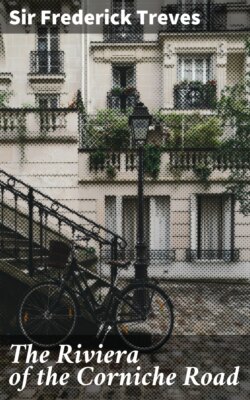Читать книгу The Riviera of the Corniche Road - Sir Frederick Treves - Страница 8
На сайте Литреса книга снята с продажи.
III
NICE: THE PROMENADE DES ANGLAIS
ОглавлениеTable of Contents
NICE is a somewhat gross, modern seaside town which is beautiful in its situation but in little else. It lies at the mouth of a majestic valley and on the shores of a generous bay, open to the sun, but exposed at the same time to every villainous wind that blows. It is an unimaginative town with most excellent shops and a complete, if noisy, tramway system. It is crowded, and apparently for that reason popular. It is proud of its fine sea front and of the bright and ambitious buildings which are ranged there, as if for inspection and to show Nice at its best.
The body of the town is made up of a vast collection of houses and streets of a standard French pattern and little individuality. Viewed from any one of the heights that rise above it, Nice is picturesque and makes a glorious, widely diffused display of colour; but as it is approached the charm diminishes, the dull suburbs damp enthusiasm, and the bustling, noisy, central streets complete the disillusion. On its outskirts is a crescent of pretty villas and luxuriant gardens which encircle it as a garland may surround a plain, prosaic face. The country in the neighbourhood of this capital of the Alpes Maritimes is singularly charming, and, therefore, the abiding desire of the visitor to Nice is to get out of it.
Along the sea front is the much-photographed Promenade des Anglais with its line of palm trees. It is marked with a star and with capital letters in the guide books and it is quite worthy of this distinction. It appears to have been founded just one hundred years ago to provide work for the unemployed. To judge from the crowd that frequents it, it is still the Promenade of the Unemployed.
The Promenade has great dignity. It is spacious and, above all, it is simple. As a promenade it is indeed ideal. It is free from the robust vulgarity, the intrusions, and the restlessness of the parade in an English popular seaside resort. There are no penny-in-the-slot machines, no bathing-houses daubed over with advertisements, no minstrels, no entertainments on the beach, no importunate boatmen, no persistent photographers. If it gives the French the idea that it is a model of a promenade of the English, it will lead to an awakening when the Frenchman visits certain much-frequented seaside towns in England.
A little pier—the Jetée-Promenade—steps off from the main parade. On it is a casino which provides varied and excellent attractions. The building belongs to the Bank Holiday Period of architecture and is accepted without demur as exactly the type of structure that a joy-dispensing pier should produce. It is, however, rather disturbing to learn that this fragile casino, with its music-hall and its refreshment bars, is a copy of St. Sophia in Constantinople. That mosque is one of the most impressive and most inspiring ecclesiastical edifices in the world, as well as one of the most stupendous. Those who know Constantinople and have been struck by the lordly magnificence of its great religious fane will turn from this dreadful travesty with horror. It is a burlesque that hurts, as would the “Hallelujah Chorus” played on a penny whistle.
It is along the Promenade des Anglais—the Promenade of the Unemployed—that the great event of the Carnival of Nice, the Battle of Flowers, is held every year. The Carnival began probably as the modest festa of a village community, a picturesque expression of the religion of the time, a reverent homage to the country and to the flowers that made it beautiful. It seems to have been always associated with flowers and one can imagine the passing by of a procession of boys and girls with their elders, all decked with flowers, as a spectacle both gracious and beautiful.
It has developed now with the advancing ugliness of the times. The simple maiden, clad in white, with her garland of wild flowers, has grown into a coarse, unseemly monster, blatant and indecorous, surrounded by a raucous mob carrying along with it the dust of a cyclone. The humble village fête has become a means of making money and an opportunity for clamour, licence and display. Reverence of any kind or for anything is not a notable attribute of the modern mind; while with the advance of a pushing democracy gentle manners inevitably fade away.
It is pitiable that the Carnival has to do with flowers and that it is through them that it seeks to give expression to its loud and flamboyant taste. It is sad to see flowers put to base and meretricious uses, treated as mere dabs of paint, forced into unwonted forms, made up as anchors or crowns and mangled in millions. The festival is not so much a battle of flowers as a Massacre of Flowers, a veritable St. Bartholomew’s Day for buds and blossoms.
